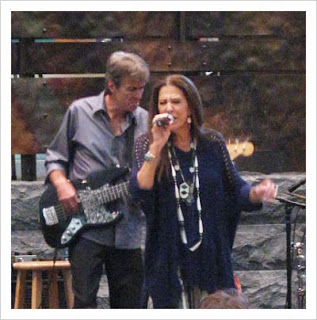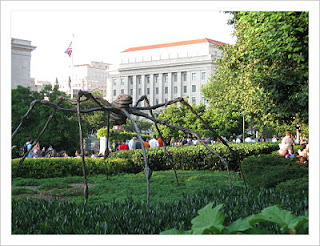 Rita Coolidge in a free concert at the National Museum of the American Indian, August 10, 2013/Patricia Leslie
Rita Coolidge in a free concert at the National Museum of the American Indian, August 10, 2013/Patricia Leslie
Never know how much I love you, never know how much I care
When you put your arms around me, I get a fever that's so hard to bear
You give me fever - when you kiss me, fever when you hold me tight
Fever - in the the morning, fever all through the night.
When you put your arms around me, I get a fever that's so hard to bear
You give me fever - when you kiss me, fever when you hold me tight
Fever - in the the morning, fever all through the night.
In a free concert Saturday afternoon at the Smithsonian's National Museum of the American Indian, Rita Coolidge charmed hundreds in the Potomac Atrium for almost 90 minutes, singing her classics in her gentle, distinctive voice, instantly recognizable and unchanged over the four decades she has been a star.
 Rita Coolidge in a free concert at the National Museum of the American Indian, August 10, 2013/Patricia Leslie
Rita Coolidge in a free concert at the National Museum of the American Indian, August 10, 2013/Patricia Leslie
Among the numbers she sang were "Fever," "Your Love Has Lifted Me (Higher and Higher)," "Come Rain or Come Shine," "We're All Alone," "The Way You Do the Things You Do," "Only You," "Bird on a Wire," and "How Sweet It Is to be Loved by You."
Eric Clapton was on her mind in 1969 when she wrote "Superstar":
Long ago, and, oh, so far away
I fell in love with you before the second show
Your guitar, it sounds so sweet and clear
But you're not really here, it's just the radio
I fell in love with you before the second show
Your guitar, it sounds so sweet and clear
But you're not really here, it's just the radio
Don't you remember, you told me you loved me baby?
You said you'd be coming back this way again baby
Baby, baby, baby, baby, oh baby
I love you, I really do
You said you'd be coming back this way again baby
Baby, baby, baby, baby, oh baby
I love you, I really do
When she originally recorded "I'd Rather Leave While I'm in Love," she said she didn't understand what it was all about since she was not divorced. But she discovered the meaning later.
 Rita Coolidge and her band gave a free concert at the National Museum of the American Indian, August 10, 2013, which followed a concert at the museum's New York City location. It was a rarity and welcome sight to see a woman, Mary Ekler, as a band member. Thanks, Rita! Other band members were Randy Landas, bass and guitar; John McDuffie, guitar; Lynn Coulter, drums/Patricia Leslie
Rita Coolidge and her band gave a free concert at the National Museum of the American Indian, August 10, 2013, which followed a concert at the museum's New York City location. It was a rarity and welcome sight to see a woman, Mary Ekler, as a band member. Thanks, Rita! Other band members were Randy Landas, bass and guitar; John McDuffie, guitar; Lynn Coulter, drums/Patricia Leslie Rita Coolidge with Randy Landas in a free concert at the National Museum of the American Indian, August 10, 2013/Patricia Leslie
Rita Coolidge with Randy Landas in a free concert at the National Museum of the American Indian, August 10, 2013/Patricia Leslie
Ms. Coolidge, of Cherokee Indian ancestry, saved the best for last: Amazing Grace, the Cherokee National Anthem. She briefly described the sad story of the Trail of Tears, the saga of 1838 when President Andrew Jackson forced the last 16,000 Cherokees to leave Georgia, Alabama, North Carolina and Tennessee and travel to what became Oklahoma, literally following in the footsteps of their brothers and sisters who had earlier moved. Thousands died on the journey, including 60,000 of the 130,000 Cherokees driven away. The Indian Removal Act of 1830 banished all Indians from east of the Mississippi River. (Click here to see their trails. And here for more information.)
Ms. Coolidge's powerful song and story brought the hall to a standstill. Babies quietened, talkative youth grew silent, and even the noisy guards on the upper floors ceased shouting at visitors standing along the stairwell to listen to the singer's message which evoked passions for peace, and emotions, including among those without known Indian heritage.
 Rita Coolidge with Randy Landas on bass and Lynn Coulter on drums in a free concert at the National Museum of the American Indian, August 10, 2013/Patricia Leslie
Rita Coolidge with Randy Landas on bass and Lynn Coulter on drums in a free concert at the National Museum of the American Indian, August 10, 2013/Patricia Leslie It just looks like church, but it was the audience who came to see and listen to Rita Coolidge in a free concert at the National Museum of the American Indian, August 10, 2013/Patricia Leslie
It just looks like church, but it was the audience who came to see and listen to Rita Coolidge in a free concert at the National Museum of the American Indian, August 10, 2013/Patricia Leslie The crowd gave Rita Coolidge and her band a standing ovation at the end of their free concert at the National Museum of the American Indian, August 10, 2013/Patricia Leslie
The crowd gave Rita Coolidge and her band a standing ovation at the end of their free concert at the National Museum of the American Indian, August 10, 2013/Patricia Leslie







.jpg)













 Anybody here old enough to remember the Corsair?/Patricia Leslie
Anybody here old enough to remember the Corsair?/Patricia Leslie















